
Rights Reserved - Free Access.
This digital object is protected by copyright and/or related rights. This digital object is accessible without charge, but its use is subject to written permission.
Unless expressly stated otherwise in the licensing conditions, you are free to make any of the acts permitted by your national copyright and related rights act, including browsing, printing and making a copy for your own personal purposes.
All other acts of reproduction and communication to the public are subject to the licensing conditions attached to the digital object.
ARMY BOOTS OF THE WORLD. REVIEWS
Important notice: we do not sell any boots! The prices are given for information purposes only!
USA ![]()
American Military Boots (Mildew & Water Resistant, DMS, Speed-Lacing, Black Combat Boots)
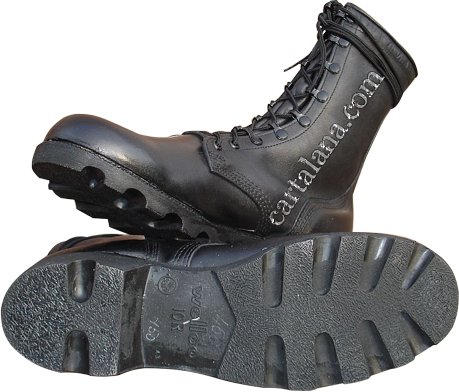
Figure 1
The US "Combat Boots, Mildew & Water Resistant, Direct Molded Sole (DMS)" were used by the US Armed Forces for about 20 years, from 1984 to 2004, when the United States Army transitioned from M81 Battle Dress Uniform (BDU) and Desert Camouflage Uniform (DCU) worn in the 1980s - 1990s, to the current US Army Combat Uniform (ACU) and Flame-Resistant Army Combat Uniform (FRACU - flame-retardant variant of the ACU).
The US Air Force, US Navy and US Marine Corps also got rid of widely-used BDU (Battle Dress Uniform) and introduced their own kinds of uniform; Airman Battle Uniform (ABU), Navy Working Uniform (NWU) and Marine Corps Combat Utility Uniform (MCCUU).
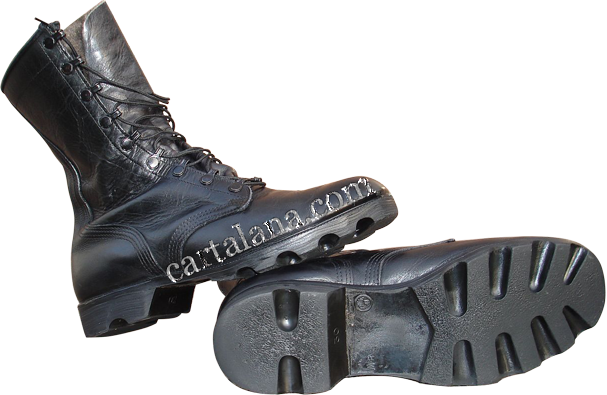
Figure 2
Along with new uniform, different branches introduced more practical, non-shine rough-out leather combat boots of different color shades (tan, coyote, sage green etc.) according to their own requirements and specifications. This left the black leather shine boots behind, and wearing of any black combat boots is generally not authorized with the currently used uniform, with the exception of some cases (safety boots, cadet's parade footwear in conjunction with the BDU...etc.).
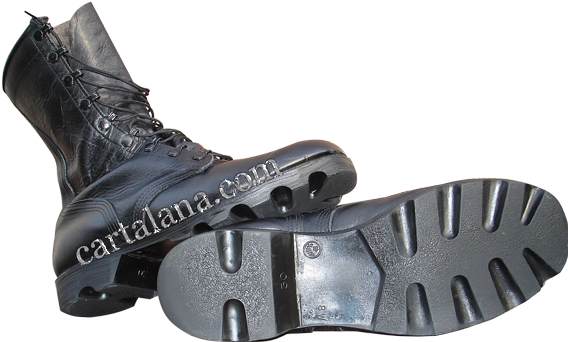
Figure 3
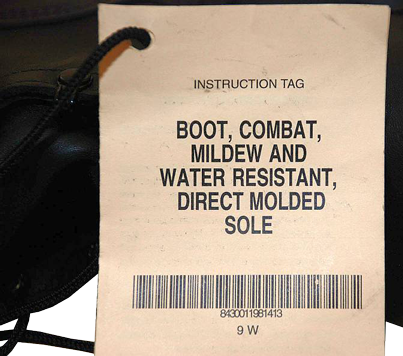
Figure 4
The predecessors of the US "Combat Boots, Mildew & Water Resistant, Direct Molded Sole (DMS)" were the so-called "Black Leather Combat Boots with Direct Molded Sole", which were standardized during the Vietnam war in 1967 and were issued at least to the mid 1980s.

Figure 5
Military specification of these boots, MIL-B-43481, was finally canceled in the year 1990. These boots were a kind of Direct Molded Sole boots, similarly to the previously designed and specified US "jungle" boots. US Army Black Leather Combat Boots featured nine pairs of simple round eyelets (four pairs of eyelets at the foot and five pairs in the upper part of lacing), subdivided by a dent-shaped cutout. The first specification made provisions for ten pairs of eyelets.
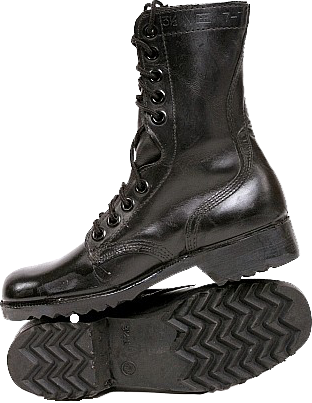
Figure 6
The leather heel counter (cap) goes up in the later specification, but in the early specification the heel counter was short, just "wrapped around" the heel.
The size and widths information, as well as manufacturer's code (contractors initials) and the date of production are hot-press stamped into the leather around the top cuff of the boot (on the inner sides of the padding "collar" of the boot's upper). There were eleven size options (American sizing), each of them had five width options. The width is indicated as an abbreviation, for each size there were provided the following widths: XN (Extra Narrow), N (Narrow), R (Regular), W (Wide) and XW (Extra Wide).
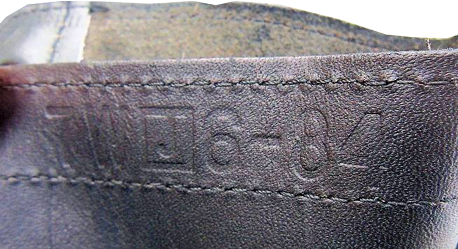
Figure 7
On the Figure 7 one can see an example of stamping for "Boots, Combat, Direct Molded Sole":
"7 W /J/ 6-86" means:
- Size 7,
- Wide width,
- "J" is the code of Contractor-manufacturer ("Belleville Boot Company")

Figure 8
- former "Belleville Shoe Manufacturing Co.", located in Belleville, Illinois);
- Manufacturing date - June 1986".
Another examples of stamping for these boots by "J" (Belleville): 6 W /J/ 9-89 and 13 XN /J/ 8-87, that means, correspondingly, sizes 6 Wide and 13 Extra Narrow, manufactured in September 1989 and August 1987.

Figure 9
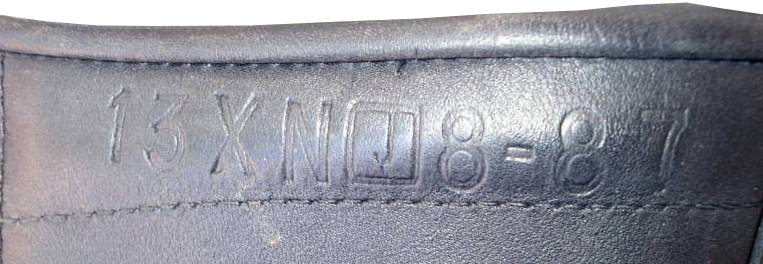
Figure 10
The National Stock Numbers (NSN) for these boots were: 8430-00-782-3131 and 8430-01-030-2147.
Although these boots were copied (more or less exactly) by the Armed Forces of such countries as Israel, Norway and Greece, the users of these boots revealed some weak points:
- too thin but rigid out-sole (uncomfortable for long walks);
- shallow "chevron"-type tread pattern provided not the best adherence with most surfaces;
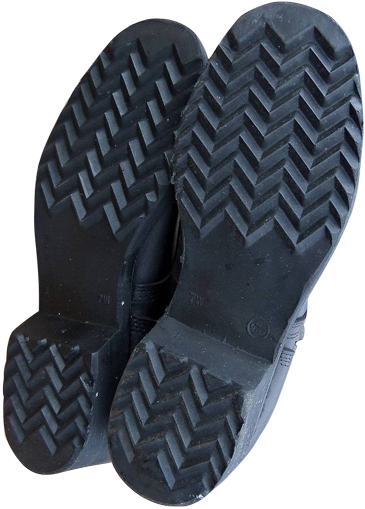
Figure 11
- absence of soft padding "collar" on top, preventing the ingress of water, dust and small pebbles inside the boots;
- the boot's tongue was not stitched high to the boot's top, so the upper half of the lacing was not protected from water ingress;
- the lacing system was conventional, with simple round eyelets, not "speed-lace".
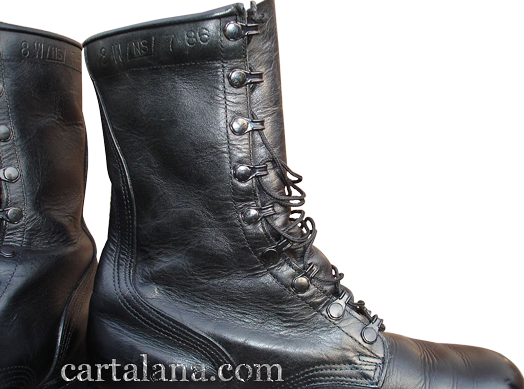
Figure 12
All these matters were improved in the framework of new military specification MIL-B-44152 of October 30, 1984 for the so called "Boots, Combat; Mildew & Water Resistant, Direct Molded Sole". These boots were developed in the beginning of 1980s by the famous American "Natick Lab" (Research, Development and Engineering Center, located in Natick, Massachusetts), according to US Army and US Marine Corps demands and requirements.
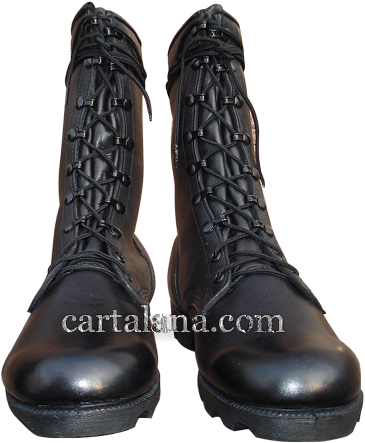
Figure 13
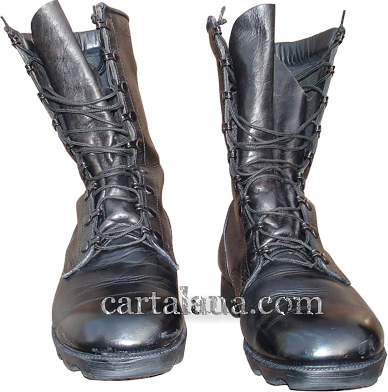
Figure 14
The early boots made by the specification MIL-B-44152 featured separately attached out-soles and heels: the sole was direct molded to the upper, and the heels were glued to the soles. On May 28, 1993 the specification was revised, and according to Rev C (Revision C, i.e. MIL-B-44152C) the boots already featured one-piece sole and heel, direct molded to the upper. The lacing system was modified as well.
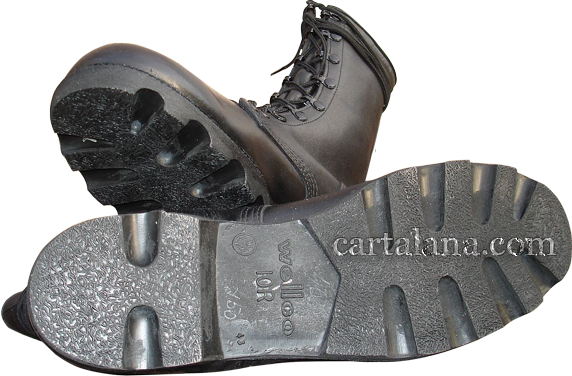
Figure 15
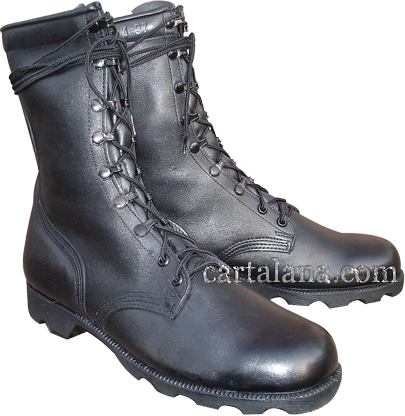
Figure 16
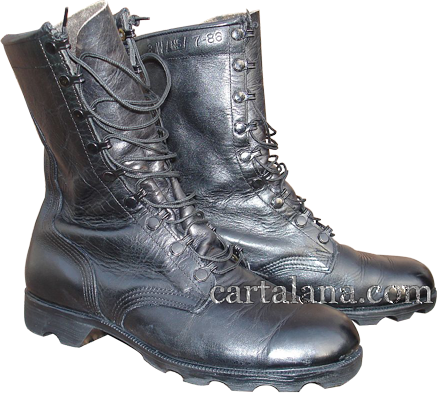
Figure 17
New American Mildew & Water Resistant Black Combat Boots featured advanced deep lug design out-soles, more thick, "self-cleaning" and providing better adhesion to most surfaces than the conventional "chevron"-type tread.
New deep lug out-soles design resembles the tread pattern of tires, which were used in different military transport vehicles, jeeps and trucks, and even on the wheels of howitzers.
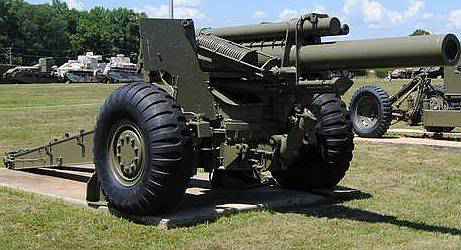
Figure 18
On the Figures 19-20 one can see the examples of the aforementioned US speed-lace boots, the early version (with non-integral out-sole)
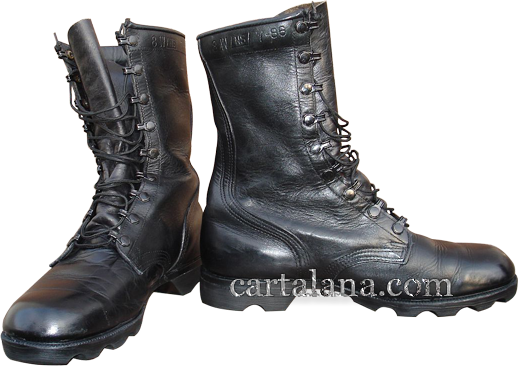
Figure 19
and later version (with cast out-sole and manufacturer's name indicated on the sole - Wellco).
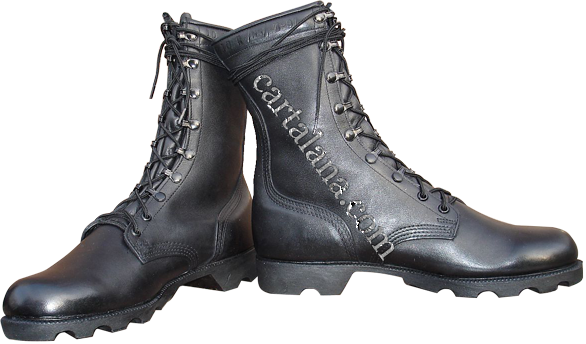
Figure 20
The soles of the early boots even show thin lined bars, which serve the reference points for precise heel attachment. The later revised version boots are single-cast and lacks these marks.
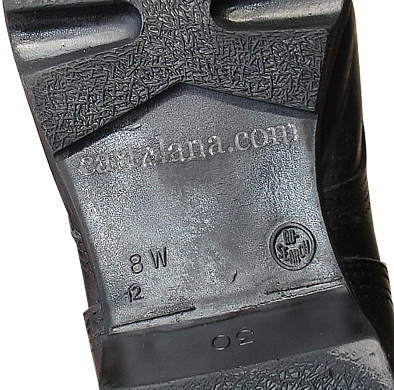
Figure 21
The both version of the boots have round-shaped "Ro-Search" logo on every sole. The presence and accuracy of this logo are the indicators of the original boots, the copy-cats usually unable to make exact and accurate stamp, because the quality of the out-soles can be achieved only with expensive DMS footwear manufacturing equipment. The manufacturers of fakes for these boots usually produce boots with not DMS soles, but with usual rubber soles, simply glued to the boot's top.
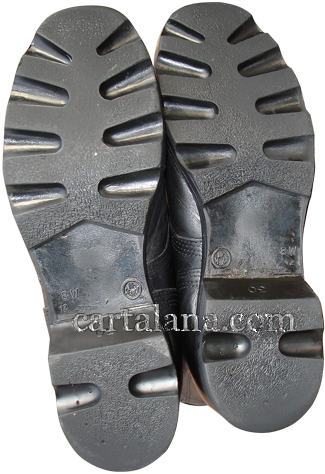
Figure 22
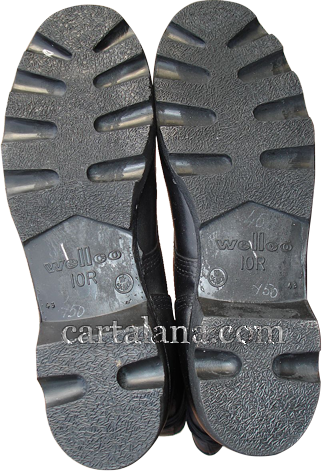
Figure 23
The fakes (with rough imitations of out-sole marking) last not long, their deterioration usually starts from the heel leather rupture, or the out-soles just fall apart.
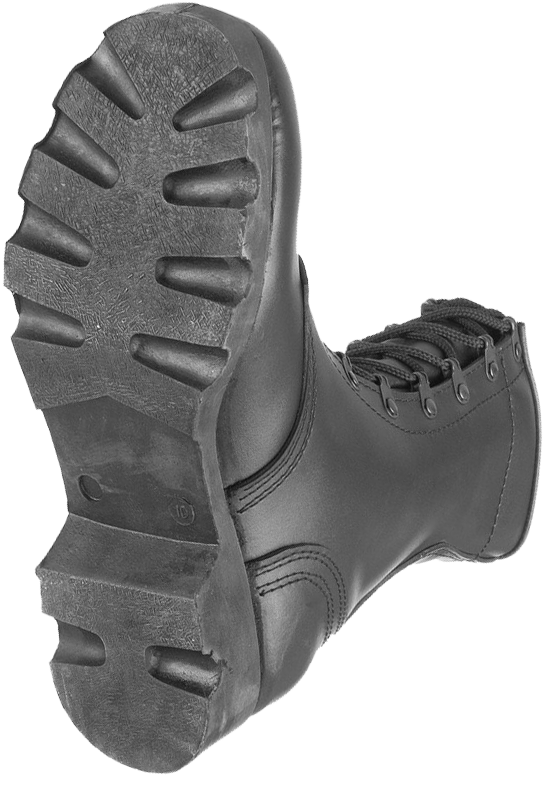
Figure 24
Similarly to the late version of previous model, specified by MIL-B-43481 (the so-called "Boots, Combat, Direct Molded Sole"), the heel caps (counters) of the boots by MIL-B-44152 go up the back of the boots, the rear side is reinforced by stitching.
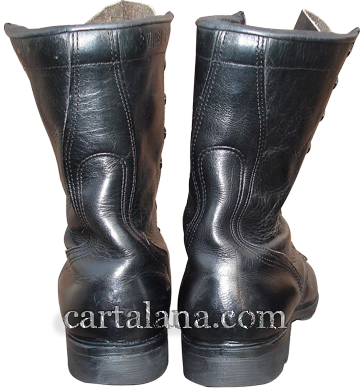
Figure 25
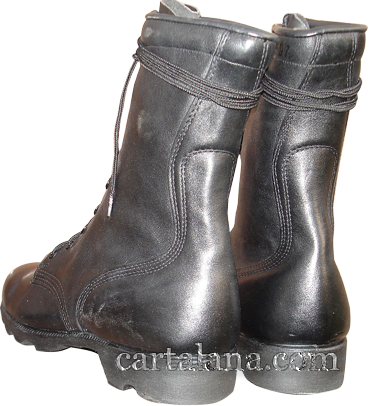
Figure 26
The previous "Combat Boots, Direct Molded Sole" (MIL-B-43481) were issued with removable orange-coloured plastic mesh insoles, as it was in the US Army boots of the 1960-70 and US "jungle boots". The same design green mesh insoles were used in contemporary German Bundeswehr military boots, prior to Modell 2000 army boots.
New type "Mildew & Water Resistant, DMS Combat Boots" (MIL-B-44152 and revised MIL-B-44152C) were issued with advanced urethane foam insole with fiberboard backing and textile upper surface.
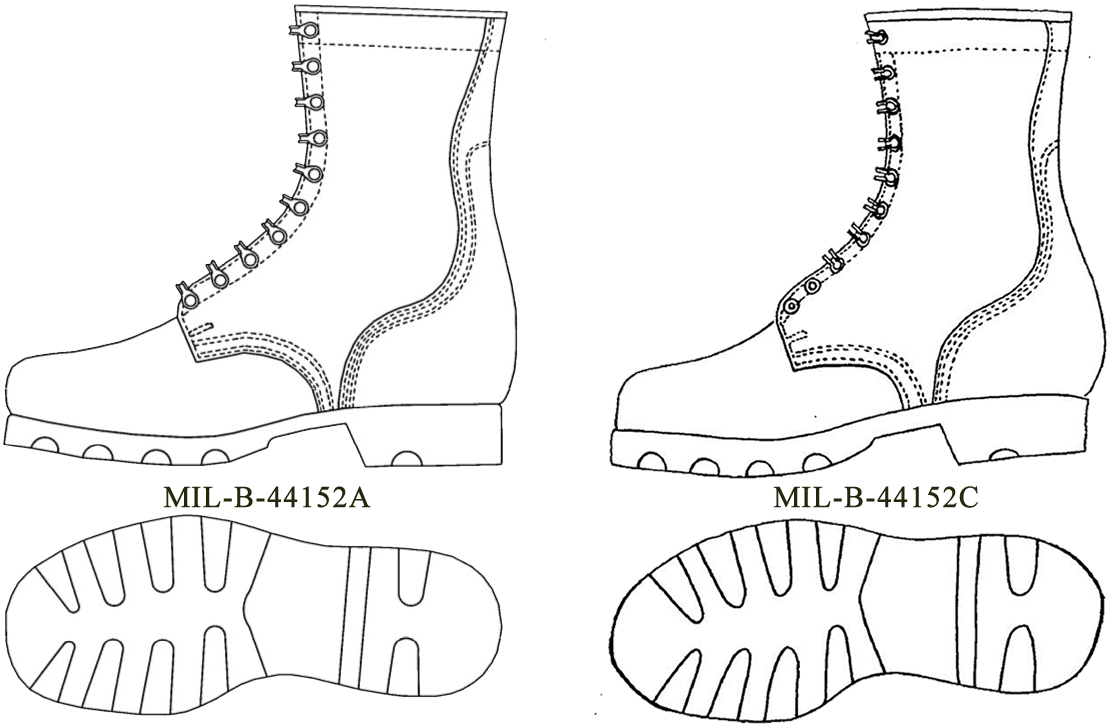
Figure 27
There were three versions (and one amendment) of military specification MIL-B-44152 by dates:
- Version A (approved November 1986) MIL-B-44152A;
- Version B (approved May 1990) MIL-B-44152B;
- Version C (approved May 1993) MIL-B-44152C;
- Amendment 1 to Version C (approved October 1994) MIL-B-44152C_AMENDMENT-1.
Initially these boots featured 10 pairs of speed-lace loops, but on May 28, 1993 the lower two pairs of speed-lace loops (at the foot), according to Revision C of the specification, were changed simple round eyelets, while the other upper eight pairs of speed-lace loops remained unchanged. Besides the peculiarities of the out-sole and the heel attachment, this feature is another important difference between the boots, made by the early and revised versions of MIL-B-44152(C) specification.

Figure 28
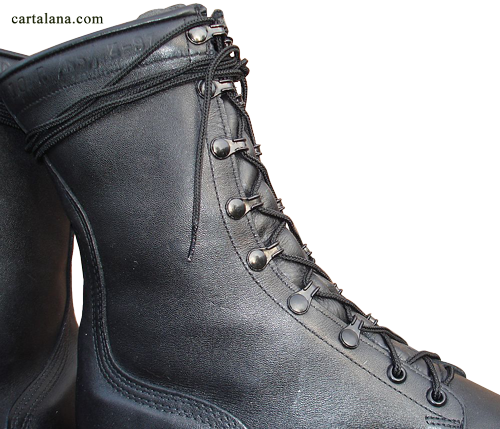
Figure 29
The size and widths information, the manufacturer's code (contractors initials) and the date of production are hot-press stamped into the leather around the top cuff of the boot (on the inner sides of the padding "collar" of the boot's upper). There were sizes for women and men, from 3 to 14 (American sizing), each of them had five width options: XN, N, R, W and XW.
The height of these boots is 10 7/8 inches, or 27,6 cm. The National Stock Numbers (NSN) for these boots were: 8430-01-198-1331, 8430-01-198-1427, 8435-01-221-3278, 8435-01-364-7089, 8435-01-366-3198.
On the Figures 30-31 one can see examples of stamping for the US Mildew & Water Resistant Black Combat Boots:
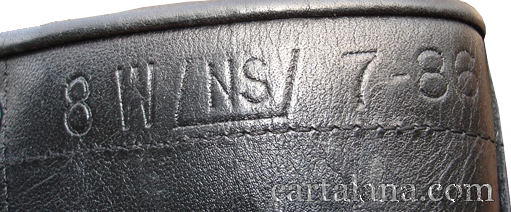
Figure 30
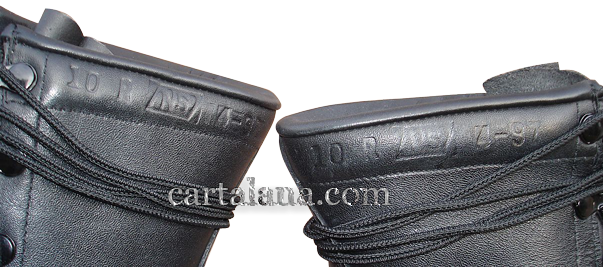
Figure 31
"8 W /NS/ 7-86"and "10 R /NS/ 4-97" mean, correspondingly:
- Size 8 (Wide width) and Size 10 (Regular width);
- "NS" is the code of "Wellco Footwear Co." ("Ro-Search" Lab.) located in Knoxville, Tennessee;

Figure 32
Figure 33
- Manufacturing dates are July 1986 and April 1997".
Among the other examples of US Armed Forces Contracted footwear manufacturers codes, one can't help mentioning such respectful company as "Altama" (code "PJ"), founded in 1969 in Darien, Georgia. On the stamp one can see: 11W /PJ/ 4-97 - size 11 Wide, manufactured in April 1997.

Figure 34
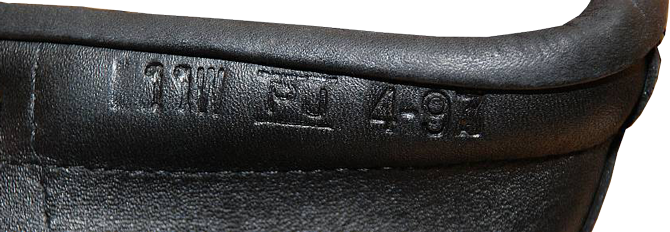
Figure 35
"Wellco" and "Altama" are among the best footwear research, develop and manufacturing companies, which were contracted suppliers of the US Ministry of Defense for decades. Since mid-August, 2014, these companies are a part of their new owner - "Original Footwear" company, which also purchased most assets of "Tactical Holdings and Operations Inc".
Exclusively for cartalana.com
We have much more interesting information on this site.
Click MENU to check it out!
∎ cartalana.com© 2009-2025 ∎ mailto: cartalana@cartalana.com